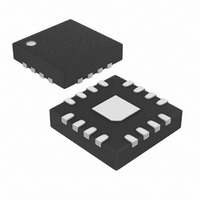MAX9722AETE+T Maxim Integrated Products, MAX9722AETE+T Datasheet - Page 10

MAX9722AETE+T
Manufacturer Part Number
MAX9722AETE+T
Description
IC AMP AUDIO .13W STER AB 16TQFN
Manufacturer
Maxim Integrated Products
Series
DirectDrive™r
Type
Class ABr
Datasheet
1.MAX9722AETET.pdf
(21 pages)
Specifications of MAX9722AETE+T
Output Type
Headphones, 2-Channel (Stereo)
Max Output Power X Channels @ Load
130mW x 2 @ 32 Ohm
Voltage - Supply
2.4 V ~ 5.5 V
Features
Depop, Differential Inputs, Short-Circuit and Thermal Protection, Shutdown
Mounting Type
Surface Mount
Package / Case
16-TQFN Exposed Pad
Product
General Purpose Audio Amplifiers
Output Power
130 mW
Common Mode Rejection Ratio (min)
- 70 dB
Thd Plus Noise
0.009 %
Operating Supply Voltage
2.4 V to 5.5 V
Supply Current
5.5 mA
Maximum Power Dissipation
1176 mW
Maximum Operating Temperature
+ 85 C
Mounting Style
SMD/SMT
Input Bias Current (max)
50 nA
Input Offset Voltage
0.5 mV
Minimum Operating Temperature
- 40 C
Supply Voltage (max)
5.5 V
Supply Voltage (min)
2.4 V
Lead Free Status / RoHS Status
Lead free / RoHS Compliant
Other names
MAX9722AETE+T
MAX9722AETE+TTR
MAX9722AETE+TTR
5V, Differential Input, DirectDrive, 130mW
Stereo Headphone Amplifiers with Shutdown
2) The voltage coefficient of the DC-blocking capaci-
The MAX9722A/MAX9722B feature a low-noise charge
pump. The 600kHz switching frequency is well beyond
the audio range and, thus, does not interfere with the
audio signals. Also, the 600kHz switching frequency
does not interfere with the 450kHz AM transceivers.
The switch drivers feature a controlled switching speed
that minimizes noise generated by turn-on and turn-off
transients. By limiting the switching speed of the
charge pump, the di/dt noise caused by the parasitic
bond wire and trace inductance is minimized. Although
not typically required, additional high-frequency noise
attenuation can be achieved by increasing the value of
C2 (see Typical Application Circuit).
Figure 4. Low-Frequency Attenuation for Common DC-Blocking
Capacitor Values
10
tor contributes distortion to the reproduced audio
signal as the capacitance value varies and the
function of the voltage across the capacitor
changes. The reactance of the capacitor dominates
at frequencies below the -3dB point and the voltage
coefficient appears as frequency-dependent distor-
tion. Figure 5 shows the THD+N introduced by two
different capacitor dielectric types. Note that below
100Hz, THD+N increases rapidly. The combination
of low-frequency attenuation and frequency-depen-
dent distortion compromises audio reproduction in
portable audio equipment that emphasizes low-fre-
quency effects such as in multimedia laptops, MP3,
CD, and DVD players. By eliminating the DC-block-
ing capacitors through DirectDrive technology,
these capacitor-related deficiencies are eliminated.
______________________________________________________________________________________
-12
-15
-18
-21
-24
-27
-30
-3
-6
-9
0
10
LOW-FREQUENCY ROLLOFF
100
FREQUENCY (Hz)
33μF
(R
100μF
L
220μF
= 16Ω)
1k
330μF
DirectDrive
10k
Charge Pump
100k
In conventional single-supply audio amplifiers, the out-
put-coupling capacitor is a major contributor of audible
clicks and pops. Upon startup, the amplifier charges
the coupling capacitor to its bias voltage, typically half
the supply. Likewise, on shutdown, the capacitor is dis-
charged to GND. This results in a DC shift across the
capacitor, which, in turn, appears as an audible tran-
sient at the speaker. Since the MAX9722A/MAX9722B
do not require output-coupling capacitors, this problem
does not arise.
Additionally, the MAX9722A/MAX9722B feature exten-
sive click-and-pop suppression that eliminates any audi-
ble transient sources internal to the device. The
Power-Up/Down Transient graph in the Typical
Operating Characteristics shows that there is minimal
DC shift and no spurious transients at the output upon
startup or shutdown.
In most applications, the output of the preamplifier driving
the MAX9722A/MAX9722B has a DC bias of typically half
the supply. At startup, the input-coupling capacitor is
charged to the preamplifier’s DC-bias voltage through the
feedback resistor of the MAX9722A/MAX9722B, resulting
in a DC shift across the capacitor and an audible
click/pop. Delaying the rise of SHDN 4 to 5 time con-
stants (80ms to 100ms) based on R
the startup of the preamplifier, eliminates this click/pop
caused by the input filter.
Figure 5. Distortion Contributed by DC-Blocking Capacitors
0.0001
0.001
0.01
0.1
10
1
10
TO DC-BLOCKING CAPACITORS
ALUM/ELEC
Click-and-Pop Suppression
ADDITIONAL THD+N DUE
100
FREQUENCY (Hz)
TANTALUM
1k
IN
and C
10k
IN
100k
, relative to











